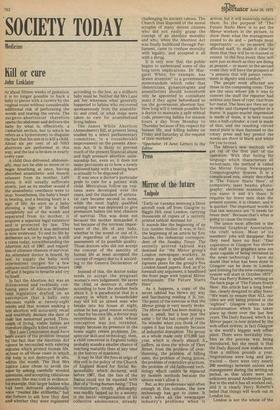SOCIETY TODAY
Medicine
Kill or cure
John Linklater
At about fifteen weeks of gestation it is no longer possible to hack a baby to pieces with a curette by the vaginal route without considerable additional risk of perforating the womb and tearing the cervix. The surgeon-abortionist therefore opens the abdomen and delivers the baby by what is, effectively, a caesarian section, but to which he refers as a hysterotomy to disguise the fact that his aim is to kill a child. About six per cent of all NHS abortions are performed in this way, and the law is broken in nearly every case.
A child thus delivered, abdominally, may not be able to move or to begin breathing at once, having absorbed anaesthetic and muscle relaxant from its mother. Left alone, it will usually suffocate slowly, just as its mother would if the anaesthetic ventilator were to stop. Nonetheless, the baby's heart is beating, and a beating heart is a sign of life. As soon as a baby showing a sign of life is lifted completely out of the womb and separated from its mother, it acquires a separate legal existence and is protected by law. The purpose for which it was delivered is now irrelevant. To end its life by deliberate act, or by neglect, is still a crime today, notwithstanding the Abortion Act of 1967, and regardless of ultimate chances of survival. An attendant doctor is bound, by law, to supply the baby with intermittent oxygen for a few minutes until the anaesthetic wears off and it begins to breathe and cry by itself.
In fact the Abortion Act was an ill-Conceived and recklessly confusing piece of Alice-in-Wonderland legislation drafted on an assumption that a baby only becomes viable at twenty-eight weeks and that women seeking a late abortion will accurately recall and truthfully declare the date of their last menstrual period. Thousands of living, viable babies are therefore illegally killed each year.
The Lane Commission must have been aware of the problem created by the fact that the Abortion Act cannot be reconciled with existing statutes which protect human life, at least in all those cases in which the baby is not destroyed in situ, within the womb. The Hon Mrs Justice Lane chose to avoid the issue by asking carefully worded questions, and accepting ridiculous answers. She was told in evidence, for example, that larger babies who had been delivered abdominally were "treated like stillbirths," but she forbore to ask how they died and whether they were registered
according to the law, as a stillborn baby must be. Neither did Mrs Lane ask her witnesses what generally happened to babies who recovered spontaneously from the anaesthetic and cried, or what steps were taken to care for anaesthetised living babies.
The James White Abortion (Amendment) Bill, at present being studied by a select parliamentary committee, is a considerable improvement on the present Abortion Act. It is likely to prevent much of the present financial abuse and high pressure abortion salesmanship but, even so, it does not make provisions as to how a 'newly delivered baby with a beating heart is actually to be disposed of.
It was once a doctor's particular pride to care for a patient with child. Meticulous follow-up routines were developed over the years, and the standard of antenatal care became second to none, while the most highly qualified nursing care was deployed to give premature babies the best chances of survival. This was done not because the mother demanded it but because of the intrinsic importance of the life of any baby, whether in the womb or out of it, and regardless of an objective assessment of its possible quality. Those doctors who did not accept the concept of the sanctity of human life at least accepted the concept of respect due, to it according to the Geneva Declaration of 1948.
Instead of this, the doctor today tends to accept the pregnant woman's own judgement. He saves the child, or destroys it, chiefly according to how the mother feels about it. It is paradoxical that in a country in which a householder may not kill an armed man who breaks into his house at night, unless he has good reason actually to fear for his own life, a doctor may nevertheless kill a child whose conception was not intended, simply because its presence in the home might create problems. Despite our skill and technology, then, a child conceived in England today probably stands a smaller chance of reaching maturity than at any time in the history of mankind.
It may be that the [onset origo of this evil is the policy of the Church of England Board for Social Responsibility which declared, well before 1967, that the fate of the foetus could not be equated with that of a "living human being." This revolutionary, trendy philosophy was readily lapped up by a society in the hectic reorganisation of its collective adolescence, already challenging its ancient taboos. The Church thus disposed of the moral scruples of many decent citizens who did not easily grasp the concept of an absolute morality and who, when the Abortion Act was finally bulldozed through Parliament, came to confuse morality with legality, and accepted it all with a shrug.
It is only now that the public begins to understand some of the long-term implications. Dr Margaret White, for example, has drawn attention* to a government memorandum which rules that obstetricians, gynaecologists and anaesthetists should henceforth only be appointed to consultant posts if they agree beforehand to toe the government abortion line. How long will it remain possible for a doctor to maintain a split ethical code, preserving babies for sixteen hours a day from Monday to Thursday because of his respect for human life, and killing babies on Friday and Saturday at the request of their mothers?
*Spectator, 14 June, Letters to the Editor


































 Previous page
Previous page